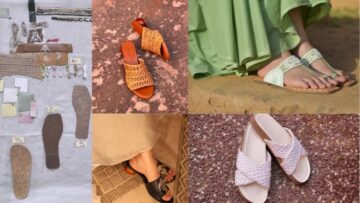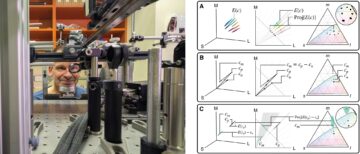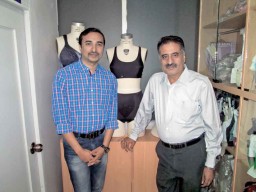
Finding success in manufacturing projects based in foreign lands, that too in case of a bra, can only be possible with a strong understanding of the product and hands-on manufacturing experience, both of which were present with Vijay Uttam, CEO, Intimate Apparels who established the Bangladeshi concern of the Indonesian pioneer in bra manufacturing, PT Busanaremaja Agracipta, setup by his father SL Uttam in 1994. “I was actively involved with my father in setting up 4 factories in Indonesia from 2001 to 2008, that too in central Java, where nobody has any experience of lingerie manufacturing. This experience of starting fresh and building the skill from ground level helped us in setting up a factory in Chittagong. At that time the only successful 100% foreign-owned lingerie manufacturing company was Hop Lun,” recalls Vijay. Not only did the Bangladesh unit gain advantage from the experience in Indonesia but also from the strong network of buyer approved vendors and technicians for lingerie manufacturing from Philippines, Sri Lanka and India.
With a setup of 1400 sewing machines, Intimate Apparels now manufactures 8,00,000 garments per month, i.e. 6,00,000 bras and 2,00,000 panties. Divided among 48 sewing lines – with 30 sewing machines per line – each line produces 750 garments per day. Unlike the generally followed system of bra manufacturing, Intimate Apparels doesn’t have separate sewing lines or groups for part preparation and final assembly. A single line with both part preparation and final assembly is fed with a day’s WIP and the next day’s WIP is kept in the racks ready to be fed to the sewing lines, as soon as the bundles keep depleting. “Presently we are operating on 50% line efficiencies and the focus is on improving the same as this not only motivates the operators to improve individual efficiencies but also encourages the supervisors to inspire the operators for multi-tasking,” added Vijay.
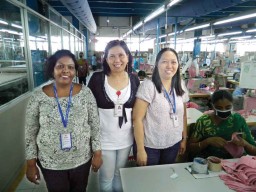
The cutting department of the company is adjacent to the sewing floor to reduce the wastes of transportation and waiting. The markers are made keeping in mind the marginal shade variation which happens across the length of the fabrics, due to which patterns of a single component are grouped as one section of the fabric, followed by groups of other parts, ensuring that the colour shade of all the bra cups per se remains the same. The cutting happens in two stages, first the fabric is spread manually and the marker spread over the fabric lays is divided into smaller fabric blocks, which are later cut into individual patterns on the band knives. “The reason we do this is because with straight knives you cannot get the necessary precision in cutting bra patterns, which is only possible through band knives,” explains Vijay Uttam. Another intervention done in the cutting is preparation of rolls of laces, which are just unwound by the cutting operators from the roll and cut in desired lengths. For matching the design on the laces being cut, pins (like in pin tables) are used to ensure that the edges have similar shaping.
The type of products being done in Intimate Apparels are of relatively lower SAM value between 5 to 15 minutes compared to the high-fashion products done in its Indonesian factories. Still the company handles around 50 styles per month and for reducing the style changeover time further, the effort is to continue a similar product on a sewing line as long as possible, and the same is taken into consideration while allotting a certain style to a sewing line. This exercise has helped in increasing the productivity and output of the sewing lines. “To further ease the process of style changeover, we do the pilot run of any style as it not only defines the targets and line structures but also the areas in the garment are also recognized, which are critical to its quality,” explains Vijay Uttam.
Quality Management
[bleft] Intimate Apparels relies on the motto of continuous improvement for future growth as an apparel manufacturer. “For 2014, we want to cross the mark of 50% average line efficiency and improve the on-time delivery percentage beyond 99% as below that it is hard to be profitable,” says Vijay Uttam. With a group turnover of US $ 100, the expansions are aimed at increasing the turnover of Bangladeshi venture from the present US $ 30 million to US $ 50 million. [/bleft]
The quality assurance starts from the material in-house stages at Intimate Apparels and all the freshly in-house goods which are yet to be inspected are segregated and kept isolated in the ‘quarantine area’ just above the inspection stations. Only after the goods have been inspected and approved, they are moved to the main inventory. “We do an AQL based inspection and if any defect is found, then 100% inspection of all the accessories and fabrics is carried out,” explains Vijay Uttam. Another important aspect handled by the quality department in the inventory is the shade matching of accessories and fabrics, by making shade bands from all the raw material lots. “We have a colour team which allocates raw material to the cutting based on the shade bands, keeping in mind that a single shade is allotted to a particular order to maintain the shade harmony in the products,” added Vijay Uttam.
Unlike most apparel manufacturing facilities a sewing line is not managed solely by a supervisor, but rather in coordination with the leader of that particular sewing line. “We have very clearly defined the job profiles of the supervisor and the leader, wherein the supervisor looks after the technical aspects of the line in terms of line balancing, output management and operation-wise operator placement, and the leader looks after the administrative and HR related issues of a sewing line,” explains Vijay Uttam. Hence it is the job of the leader to ensure that each and every machine performs at the desired level, and in case of any hindrance he/she calls the quality personnel for taking the necessary action. The quality department works as per its hierarchy and if the problem is not solved by the inline quality checker, then the quality executive is called and soon followed by the quality manager, and so on.
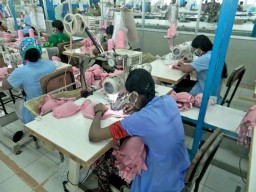
Attaching the wire casing, bottom band and outer fabric on the moulded foam cup are the sewing operations that are critical to quality of a bra. Special attachments are used for inserting the wire casing through the sewing machine, which also helps in balancing the twin needles for balanced parallel sewing and if the needle gauge and the attachment are not aligned, stitches tend to drop. For controlling the length of the elastic being fed to the machine elastic feeding and metering devices, are used for bottom band attachment. Coming to the third operation, if the outer fabric is not attached properly to the moulded cup it can be loose and even puckering can come in that region, damaging the look of the bra.
The role of the end line quality checker in the sewing lines is of utmost importance as she inspects 100% output of a sewing line. First the label attached to the garment is inspected as it has to be same to the size marked in the bundle given to the sewing line. After this the measurements are checked for every bra with utmost attention given to the length of the bottom band and the same is checked for every bra, reason being that the bottom band defines the actual size of the bra in terms of the across chest measurement. After the bottom band inspection, the bra is visually inspected for open seams, broken edges, needle marks or holes, seam puckering and the overall appearance. “Especially for checking the measurements of the bras and panties, a roving quality inspector is deployed for handling two sewing lines, whose sole job is to go from machine to machine and check the measurements on a regular basis,” shares Vijay Uttam.
[bleft] “For 2014, we want to cross the mark of 50% average line efficiency and improve the on-time delivery percentage beyond 99% as below that it is hard to be profitable.”
– Vijay Uttam [/bleft]
The finished garments are checked by the internal quality team as per the buyer defined AQL level, who select batches of 2500 pieces from every order and along with the quality head’s approval, the goods are released to the main warehouse, where they are further inspected by external QCs of the buyers. Also a part of the finished goods inspection, the material testing lab at Intimate Apparels has been given Level II certification by H&M, which enables them to do certain test like colour fastness to water & perspiration and phenolic yellowing, etc. on garments in-house.
Operator Skill Development
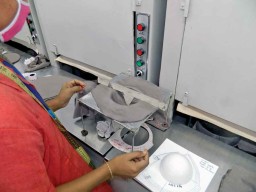
The operator training programs conducted by Intimate Apparels have laid the foundation for the growth since the beginning. “Although our training programs have been very robust and focussed from the start, but we aim to improve it further for which we have already started hiring people with KSA-Technopak and Industrial Engineering background,” adds Vijay Uttam.
The company prefers recruiting people with at least one or two years of sewing experience as there is a risk of recruiting people below 18 years, which is a big compliance issue; also on the other hand if the operators are highly skilled, it is difficult to retain them. “Sewing operators with this much minimum experience are well acquainted with the sewing machines and are very trainable, with adequate literacy level for reading the measurements and instructions,” explains Vijay Uttam.
Fresh operators are taken through machine handling and basics of the product for the initial couple of weeks, and later based on the operation being done by them the direction of skill development is defined. “The questions faced by us is whether to multi-skill the operators or not. If an operator is doing a bartack operation there is no point in multiskilling that operator, and so the focus is on teaching them how to do better a bartack operation by methods improvement. However in case of an operator working on a single needle lockstitch machines, we encourage them to do more operations to increase the man-machine utilization, by clubbing consecutive lockstitch operations,” asserts Vijay Uttam. Another direction of multi-skilling in Intimate Apparels is to teach operators a set of sewing operation that fluctuate from style to style, like elastic attachment done on a zigzag machine, so these operators would also know operations like zigzag topstitch on the bottom band and under arm region and attaching hook & eye with label.
Due to so many upcoming lingerie factories in Bangladesh, the dearth of skilled operators is being felt by many companies including Intimate Apparels. “It is easier for them to switch jobs as they can sell themselves very easily by knowing more than one sewing operation. But multi-skilling is not an option, it is our requirement and by not multi-skilling them, we are making the person less useful for the organisation,” opines Vijay Uttam. However necessary steps are being taken by Intimate Apparels for retaining them by giving them not only good pay but a proper growth path.
The biggest advantage of such a well-defined approach to multi-skilling has been presence of zero helpers in the sewing lines right from the start, apart from a manual operator for inserting the wire in the wire casing under the bra cups. “People didn’t like this system in the beginning but later they understood the benefits both to the company and themselves,” shares Vijay Uttam. This intervention was in line with the recent wage increase in the country as the total wage of an operator-helper combination is exactly double that of a single sewing operator but the difference in the productivity is very marginal, which is easily covered by the saving in terms of the wages.
Moulding Capabilities
Intimate Apparels boasts of having an in-house fabric and foam moulding department, making the company a part of the handful of companies in Bangladesh with in-house moulding capabilities. “The mindset has to be altered for developing an in-house moulding department as one has to learn an entirely new trade, because it is completely different from any other department of apparel manufacturing,” avers Vijay Uttam. Also done in-house by the company, the foam lamination lays the foundation of the moulding department. Glue-based lamination of fabric to fabric and fabric to foam can be done with the lamination machines. After the glue has been applied, the fabrics go through the heating roller and the pressure roller. “Fabric to fabric lamination is necessary because some areas of a bra require a certain level of rigidity which a simple knit fabric cannot provide, so we use double layered fabrics at some areas like the centre front and the wings,” explains Vijay Uttam.
The moulding department houses 36 moulding machines with an hourly output of 120 pieces per machine. Indicative lines are marked on the moulded templates to ensure that the operators place the cut part precisely in the moulding machine, so that the right shape is produced. The depth, circumference and shaping of the moulded fabrics is of utmost importance and their adherence to the measurements is ensured via indigenously developed work aids. The moulded cups are also checked for fabric decolouration. For ensuring that the above parameters are met for each and every moulded cup, a roving QC regularly inspects the moulded fabric cups. Another important aspect taken in consideration by the quality assurance department is that the temperature, time and pressure settings are not changed for a machine, as they differ from fabric to fabric and define the quality of the moulded cups. “The depth of the moulded cups is monitored regularly and if a variation arises in the depth of consecutive cups it indicates that someone has certainly fiddled with the settings of the machine. To ensure the same, after every two hours one person regularly checks the temperature, pressure and timer setting of each moulding machine. This person is only responsible for checking the machine settings and nothing else,” explains Vijay Uttam.
Future Plans
Intimate Apparels is in the process of setting up a new facility adjacent to its already existing one, which would be commissioned by June 2014. The plan is of adding another 24 sewing lines, a total of 720 sewing machines, which will increase the number lines from 48 to 72. “In the new upcoming facility we would be having a centralized cutting department with an automatic cutter,” concludes
Vijay Uttam.



